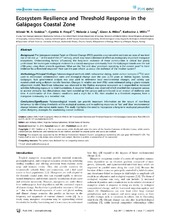| dc.contributor.author | Seddon, Alistair | eng |
| dc.contributor.author | Froyd, Cynthia A. | eng |
| dc.contributor.author | Leng, Melanie J. | eng |
| dc.contributor.author | Milne, Glenn A. | eng |
| dc.contributor.author | Willis, Katherine Jane | eng |
| dc.date.accessioned | 2012-02-27T11:00:49Z | |
| dc.date.available | 2012-02-27T11:00:49Z | |
| dc.date.issued | 2011-07-21 | eng |
| dc.Published | LoS ONE 6(7): e22376 | en |
| dc.identifier.issn | 1932-6203 | en_US |
| dc.identifier.uri | http://hdl.handle.net/1956/5643 | |
| dc.description.abstract | Background: The Intergovernmental Panel on Climate Change (IPCC) provides a conservative estimate on rates of sea-level rise of 3.8 mm yr21 at the end of the 21st century, which may have a detrimental effect on ecologically important mangrove ecosystems. Understanding factors influencing the long-term resilience of these communities is critical but poorly understood. We investigate ecological resilience in a coastal mangrove community from the Gala´pagos Islands over the last 2700 years using three research questions: What are the ‘fast and slow’ processes operating in the coastal zone? Is there evidence for a threshold response? How can the past inform us about the resilience of the modern system? Methodology/Principal Findings: Palaeoecological methods (AMS radiocarbon dating, stable carbon isotopes (d13C)) were used to reconstruct sedimentation rates and ecological change over the past 2,700 years at Diablas lagoon, Isabela, Gala´pagos. Bulk geochemical analysis was also used to determine local environmental changes, and salinity was reconstructed using a diatom transfer function. Changes in relative sea level (RSL) were estimated using a glacio-isostatic adjustment model. Non-linear behaviour was observed in the Diablas mangrove ecosystem as it responded to increased salinities following exposure to tidal inundations. A negative feedback was observed which enabled the mangrove canopy to accrete vertically, but disturbances may have opened up the canopy and contributed to an erosion of resilience over time. A combination of drier climatic conditions and a slight fall in RSL then resulted in a threshold response, from a mangrove community to a microbial mat. Conclusions/Significance: Palaeoecological records can provide important information on the nature of non-linear behaviour by identifying thresholds within ecological systems, and in outlining responses to ‘fast’ and ‘slow’ environmental change between alternative stable states. This study highlights the need to incorporate a long-term ecological perspective when designing strategies for maximizing coastal resilience. | en_US |
| dc.language.iso | eng | eng |
| dc.publisher | Public Library of Science | en_US |
| dc.rights | Attribution CC BY | eng |
| dc.rights.uri | http://creativecommons.org/licenses/by/2.5/ | eng |
| dc.title | Ecosystem Resilience and Threshold Response in the Gala´pagos Coastal Zone | en_US |
| dc.type | Peer reviewed | |
| dc.type | Journal article | |
| dc.description.version | publishedVersion | en_US |
| dc.rights.holder | Copyright 2011 Seddon et al. | en_US |
| dc.identifier.doi | https://doi.org/10.1371/journal.pone.0022376 | |
| dc.subject.nsi | VDP::Mathematics and natural science: 400::Zoology and botany: 480::Ecology: 488 | en_US |

